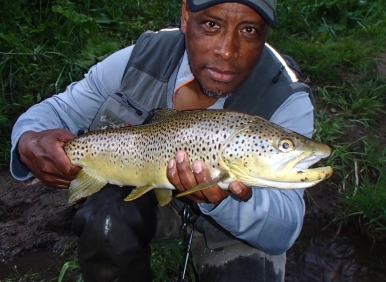By T. Gordon SFBCA Member.
The splash of a brown trout taking a fly of the surface of the water is the kind of stuff dreams are made of for a fly fisherman. We live for that moment. We spend hours tying what we think would be the perfect fly. We go to bed late dreaming of the beautiful fish striking that very fly… jumping out of the water while we hold the line tight.
If you have ever seen fish rising in a stream, you know they are coming up to catch insects that are hatching on the surface of the water. Often, these insects hatch in large numbers, so abundant that the trout would lock on to them and take nothing else. This “locking” onto a specific insect species is also a good reason for the fly fisherman to lock on that same species in what is called “matching the hatch”. Which is nothing more than matching the appearance of the insects hatching at the moment.

A well used Quill Gordon and one of the fish that took it
Some of the most important aquatic insects for a fly fisherman are “mayflies”. Mayflies are the short lived adult stage of many insect species and despite of their name they can hatch at different times during the year, some having multiple hatches in one single year. A few species are small and very common, like the well known Blue Winged Olive (Baetis ). Others larger and very abundant during the short few weeks of early spring, like the famous Quill Gordon (Epeorus Pleuralis), the Hendrickson (Ephemerella Subvaria) and the Adams (Siphlonurus) . Then we have at the extreme end, the very large and very rare Green Drake (Ephemera Guttulata). Other names that come to mind are the Pale Evening Dun, the Rusty Spinner, etc., their importance to the fly fisherman depends on the abundance of the hatch, the geography, the fish species, the condition of the stream, even the angler’s choice and other factors.

A Green Drake spinner or imago -the last stage of this insect
I have been lucky enough to be in the stream on spring days during large hatches of mayflies and these have been some of my best fly fishing experiences. A variety of dry fly patterns based on different mayfly species have been developed through the years. The two most common patterns I use are the Quill Gordon and the Hendrickson. Of course you don’t have to stick to the existing patterns – after all most of them are just variations of the same idea.

My Version of the Green Drake Spinner (imago) -the simple green
With basic fly tying skills, a little bit of creativity and a bit of time you can create your own pattern -my personal preference is to vaguely imitate the naturals. I was lucky once to be in the stream when the Green Drakes were hatching. Unfortunately I had nothing in my fly box that would match this unique mayfly. That evening I went home and using whatever materials I had at hand, developed my own mayfly pattern. I call it the “Simple Green”

The fish that took my Green Drake imitation
mayfly. I used deer hair for the tails, wool yarn for the body, goose feathers for the wing and dun coloured dry fly hackle. I am proud to say that my own personal pattern caught me my own personal record -the biggest brown trout I have ever caught on the dry fly.
I hope you take my suggestion: this spring hit the water with your dry flies, put the time and the effort and enjoy the rewards.

Pingback: SFBCA Meeting February 4, 2020 | Scarborough Fly and Bait Casting Association